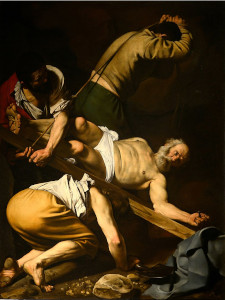Revelation
III. Structure
A. Step A1: Prologue (1:1-9)
B. Step B1: Heavenly vision and letter to the Seven Churches (1:10-3:22)
C. Step C1: Seven Seals (4:1-8:1)
D. Step D: Parallels
1. Parallel 1a: Seven Trumpets (8:2-11:19)
2. Parallel 2a: Great Controversy (12:1-14:20)
3. Parallel 1b: Seven Plagues (15:1-16:21)
4. Parallel 2b: Fall of Babylon (17:1-19:10)
E. Step C2: Millennium (19:11-20:15)
F. Step B2: New Jerusalem (21:1-22:5)
G. Step A2: Epilogue (22:6-17)
A. Chiastic form and parallels
The structure of Revelation showed interesting parallels. Besides matching the Prologue and Epilogue (Step A), the "B" Steps (Seven Churches in 1:10-3:22 and the New Jerusalem in 21:1-22:5) focused upon the Church of the saved. The "C" Steps (Seven Seals in 4:1-8:1 and the Millennium in 19:11-20:15) referred to the revelation and fulfillment of divine will.
The "D" Step had two sets of parallels. The first publicly announced the divine will (Seven Trumpets in 8:2-11:9) and enforced it (Seven Plagues in 15:1-16:21). Notice the three sets of seven referred to implementing a royal decree. A noble would receive the law and break open the royal seal, thus implicitly recognizing the authority of the king. Then, he would have the decree announced to the populace in the marketplace, preceded by a trumpet blast that would grab the attention of the people. Finally, he would enforce the decree through appropriate action. Since the number seven meant perfection, the three sets of the number (seals, trumpets and bowls) designated fulfillment of the divine plan.
The final parallel focused upon two female figures and their destiny (Heavenly Woman in 12:1-14:20 and the Whore of Babylon in 17:1-19:10); the appearance of the Heavenly woman giving birth held the key to Revelation. If we assume John wrote Revelation in a chiastic form, we should look to the center of the text to focus on his core insight. We can find it in Rev 11:19-12:5: the Incarnation as the fulfillment of divine revelation. In the author's mind, the birth of the Messiah opened the heavenly Holy of Holies to the cosmos, revealing the divine presence to all. Note the God's plan for the cosmos (breaking open the Seven Seals as revelation and the Seven Trumpets as the public announcement of that revelation) led up to the Incarnation.
B. Martyrdom connects
heavenly praise and divine justice

Crucifixion of St. Peter
by Caravaggio
The remainder of Revelation consisted of the destiny for those who accepted or rejected the presence of the Messiah, many times from the perspective of heavenly worship. In the text, such celestial praise mimicked ancient temple cult where the temple was home to the god's presence, the altar before the temple (inner court) focused worship with animal sacrifices and the multitudes stood outside the altar area (outer court). In John's vision, the throne of God and the Lamb replaced the temple building (see Eze 1:5-11; Rev 4:2-3), the altar stood before the throne (Rev 9:13) and the multitude of the saved (four living creatures in Rev 4:6-7, 24 elders in Rev 4:4 and the rest of the faithful in Rev 7:1-17).
Note details about the altar. The souls of the martyrs cried out for justice from the base of the altar (see Gen 4:10; Rev 6:9-11), implying the earth upon which the altar stood; this paralleled the Jewish notion of blood as a life force returning to the earth (Lev 3:17, Lev 7:26, Lev 17:10–14, Deu 12:15–16, Deu 12:20–24) from whence it came (Gen 2:7). As the sixth of the seven trumpets, a voice from the horn of the altar (Exo 27:2) commanded the release of forces across the Euphrates River (the Parthians; Rev 9:3). The altar horns represented refuge for fugitives (1 Kings 1:50-53), so the martyrs who clung to the altar for relief gave rise to judgment against Rome. The smoke from the altar of incense rose up along with the prayers of the martyrs as praise to God (Rev 8:3). As altar sacrifice gave the life of the victim to God, it sanctified the worship area with the blood (including the horns) and added to the praise of the faithful (incense rising). In this sense, John implied martyrdom was an act of worship, thus complimenting the sacrifice of the Cross. When Christians gave their lives for the faith, they glorified God.
Did John equate divine glory with divine justice? In Exo 24:3-8, Moses ratified the covenant with a sacrifice of oxen, filling the victims' blood in basins, pouring half of the blood over the altar and anointing the people with the other half. Rev 16:1-6 echoed this scene as divine judgment when the angel poisoned the waters with blood as a result of the "blood of the saints and prophets poured out" (Rev 16:6). The blood of the saints which Rome (the whore of Babylon) drank so lustfully (Rev 17:6) now cursed the city (Rev 18:24). Implicitly the incense laced with the prayers of the fallen (Rev 8:3) mixed with the smoke ascending from the smoldering ruins of the city (Rev 19:2). In the end, the Messiah himself would ride victorious with robes soaked in his own spilled blood (Rev 19:13). For the author, blood shed for God acted both as worship and as judgment. Hence, martyrdom connected heavenly cult for the saved and condemnation for the pagans.
Photo Attribution
Crucifixion of St. Peter. Caravaggio [Public domain]
